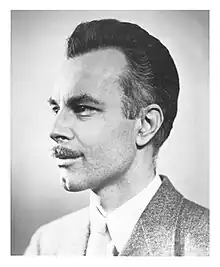George A. Philbrick
George A. Philbrick was responsible, through his company George A. Philbrick Researches (GAP/R),[1] for the 1953 commercialization and wide adoption of operational amplifiers, a now-ubiquitous component of analog electronic systems, and the invention and commercialization of electronic analog computers based on the operational amplifier principle. He also created the first electronic training simulator, the Polyphemus.[2] The invention, or co-invention, of the operational amplifier has also been credited to a number of other people, including a war-needs driven Bell Labs team led by Clarence A. Lovell (C. A. Lovell et al., 1940 ff.)[3] and Loebe Julie.[4][5][6]
George Arthur Philbrick | |
|---|---|
 George A. Philbrick. Photographer: John Brook. | |
| Born | January 5, 1913 Belmont, Massachusetts |
| Died | 1974 |
The actual naming of the operational amplifier likely occurred in the classic 1947 paper by John Ragazzini, et al.[7] However analog computations using op amps as we know them today began with the work of the Clarence Lovell-led war needs group at Bell Labs, around 1940 (acknowledged generally in John Ragazzini's paper).[8] In 1952, George A. Philbrick Researches (GAP/R) introduces the K2-W, considered the “Model T” of op amps.[9][10]
See also
External links
- The Philbrick Archive
- EEtimes.com: Unsung hero pioneered op amp
Bibliography
- Lovell, C.A., et al., "Artillery Predictor," US Patent 2,404,081, filed May 1, 1941, issued September 24, 1946. (The mathematics of analog computer system using op amps for functions of repeating, inverting and summing amplifiers, plus differentiation).
- Lovell, C.A., et al., "Electrical Computing System," US Patent 2,404,387, filed May 1, 1941, issued July 23, 1946. (An analog computer system using op amps for control).
- Lovell, C. A. "Continuous Electrical Computation," Bell Laboratories Record, 25, March, 1947, pp. 1 14–118. (An overview of various fire-control analog computational circuits of the T10 and M9 systems, many illustrating uses of op amps).
- Nyquist, H. “Regeneration theory,” Bell System Technical Journal, vol. 11, pp. 126–147, Jan. 1932.
- Black, H.S. “Stabilized feedback amplifiers,” Bell System Technical Journal, vol. 13, pp. 1–18, Jan. 1934.
- Bode, H.W. “Relations between attenuation and phase in feedback amplifier design,” Bell System Technical Journal, vol. 19, pp. 412–454, July 1940.
- Lovell, C. A. “Continuous electrical computation,” Bell Laboratories Record, vol. 25, no. 3, pp. 114–118, Mar. 1947.
- Ragazzini, J.R., Randall, R.H., and Russell, F.A. “Analysis of problems in dynamics by electronic circuits,” Proceedings of the IRE, vol. 35, pp. 444–452, May 1947.
- Philbrick, G.A. “Designing industrial controllers by analog,” Electronics, vol. 21, no. 6, pp. 108–111, 1948. Analog Circuit Design 12 34.
References
- George A. Philbrick Researches (GAP/R)
- Holst, Per A. (April 1982). "George A. Philbrick and Polyphemus: The First Electronic Training Simulator". Annals of the History of Computing. 4 (2): 143–156. doi:10.1109/MAHC.1982.10021. ISSN 1058-6180. S2CID 14019320.
- Full text of "Analog Devices-4-20m A Transmitter AD694.pdg"
- Op Amp History - Analog Devices
- Notes on Analog (mostly Operational Amplifier) - Timeline Milestones
- Recognition of M9 Designers C. A. Lovell, D. B. Parkinson, and J. J. Kuhn, "Medals for Merit," Bell Laboratories Record, Vol. 27, May, 1947, pp. 208. (The Medal for Merit awarded to the M9 designers on April 8, 1947, is the nation's highest civilian award.)
- Ragazzini, J.R., Randall, R.H., Russell, F.A. Analysis of Problems in Dynamics by Electronic Circuits. 3 (3), 54-65. September 1, 1964. DOI: https://doi.org/10.1177/003754976400300309. Accessed January 14, 2017
- John Ragazzini coined the term “operational amplifier” in his paper “Analysis of Problems in Dynamics by Electronic Circuits”. The paper included discussions and examples of op-amp amplifiers, integrators, differentiators, and summers.
- Notes on Analog (mostly Operational Amplifier) - Timeline Milestones
- Philbrick, G.A. “Designing industrial controllers by analog,” Electronics, vol. 21, no. 6, pp. 108–111, 1948. Analog Circuit Design 12 34